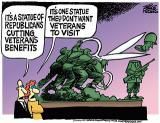28 February 2015 - A solitary fisherman crouches in the surf, his eyes skimming the surface for signs of movement in the shallows. A conical hat protects him from the afternoon sun. He is alone on the beach, which lies 14km north of the central Vietnamese city of Da Nang. Behind him, flies swarm around rubbish strewn across the sand. To a passerby it wouldn’t occur that anything of significance had ever happened here.
It was on this unremarkable stretch of Nam O Beach where, at 9.03am on 8 March 1965, 3,500 US marines disembarked from their landing crafts and waded on to Vietnam’s shores, becoming the first American ground troops to arrive in the country.
At the time, the US-backed government in South Vietnam was suffering from power struggles among its leadership and troops were deserting its army. Communist forces from North Vietnam were taking advantage, advancing down the Ho Chi Minh trail and gaining control in the countryside. Viet Cong guerrillas had attacked a US compound in the Central Highlands in February. Now, they were approaching Da Nang. General William Westmoreland requested two battalions of US marines to provide support, and at this crucial turning point, President Lyndon B Johnson agreed. read more>>>
Just after this picture was taken, these boys were evacuated from their village. Nearly half a century later, would American veterans be able to find them?
Larry Johns was 14, and in a school gym class, when he learned his brother had died. It was September 1969 and President Nixon had recently taken office, swearing to end the hugely unpopular war that was raging in Vietnam. The nation was already fervently polarised, and protesters were leading large rallies on the streets and university campuses of America. Larry’s older brother Jeff had been shipped out to a reconnaissance unit 35 miles north-west of Saigon on a mission to end the war. He’d only been gone five months when he was shipped back home in a sealed casket fastened down with a US flag.
“It was an accident,” says Larry, nearly 50 years on. “But those kinds of accidents happened all the time.”
After serving in the navy and then establishing himself in the book-printing business, Larry began seeking out veterans who had served in the same base camp as his brother. The army had been largely silent on the details behind his death, so Larry dug for photographs and details. Bit by bit he learned the truth: Jeff, then 19, had been in a group of soldiers sent out to the perimeter of their base camp to fit a 40lb shaped charge, an explosive intended to ward off enemy Vietnamese soldiers. But artillery blasts from the camp had caused a heavy static electricity that detonated the charge by accident, killing eight men. Severed fingers, limbs and shreds of uniform had rained down all over the camp. Only two of the eight bodies had remained partially intact, Larry later learned, and one of them was Jeff’s. read more>>>























No comments:
Post a Comment